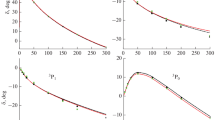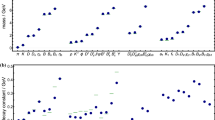Summary
We describe simple composite models for the electron, the muon and the pion. The electron is treated as a combination of a boson and a light fermion interacting via the potential energyV=−αħc/r, whereα is the fine-structure constant. The relativistic Schrödinger equation is taken to describe this system. The electron is associated with an irregular, but normalizable,l=0 eigenstate. The rest mass from which this compound is derived is shown to bem 0=70.024 MeV/c2, which we identify as a light quark q. A qq compound interacting viaV=−ħc/r is shown to have a mass of 134.82 MeV/c2. When a Yukawa-like perturbation termV′=(ħc/r) exp [−2μr] from a quark/quark potential previously suggested by us is included, the first-order mass prediction is 134.89 MeV/c2. This compound is identified with the π0. A 70 MeV fermion and a 70 MeV boson interacting with coupling constantα are shown to yield a mass of 105.29 MeV/c2 in the zeroth order for an electronlike irregular state identified with the muon. Finally, we describe zeroth-order, preliminary calculations for qq, (qq)q and (qq)(qq) compounds (m a=Nm 0,N=4, 8, 18) interacting viaV=±ħc/r that yield masses close (typically within 0.2% or less) to those of K±, η0, D0, n0, Λ0, Σ0, Θ0, vector mesons, charmed mesons, and other resonances.
Riassunto
Si descrivono semplici modelli di composti per l’elettrone, il muone e il pione. L’elettrone è considerato una combinazione di un bosone e un fermione leggero che interagiscono mediante l’energia potenzialeV=−αħc/r, dove α è la costante di struttura fine. Si usa l’equazione relativistica di Schrödinger per descrivere questo sistema. Si associa l’elettrone ad un autostatol=0 irregolare ma normalizzabile. Si mostra che la massa di quiete da cui si deriva questo composto èm 0=70.024 MeV/c2, che si identifica con un quark leggero q. Si mostra che un composto qq che interagisce medianteV=−ħc/r ha una massa di 134.82 MeV/c2. Quando si include un termine di perturbazione del tipo di Yukawa,V′=(ħc/r) exp [−2μr], da un potenziale quark/quark suggerito precedentemente, la previsione della massa del prim’ordine è 134.89 MeV/c2. Si identifica questo composto con π0. Si mostra che un fermione di 70 MeV e un bosone di 70 MeV che interagiscono con una costante di accoppiamento α producono una massa di 105.29 MeV/c2 nell’ordine zero per uno stato irregolare che si identifica con il muone. Infine si descrivono i calcoli preliminari di ordine zero per i composti qq, (qq)q e (qq)(qq) (m q=Nm 0,N=4, 8, 16) che interagiscono medianteV=±ħc/r che generano masse prossime (tipicamente fino allo 0.2% o meno) a quelle di K±, η0, D0, n0, Λ0, Σ0, θ0, dei mesoni vettoriali, dei mesoni con incanto e di altre risonanze.
Similar content being viewed by others
References
J. C. Pati, A. Salam andJ. Strathdee:Phys. Lett. B,59, 265 (1975);C. G. Callan jr.,R. F. Dashen andD. J. Gross:Phys. Rev. D,19, 1826 (1979);R. Casalbuoni andR. Gatto:Phys. Lett. B,93, 47 (1980);E. J. Squires:Phys. Lett. B,94, 54 (1980);H. Harari andN. Seiberg:Phys. Lett. B,98, 269 (1981);H. Yukawa:Phys. Rev.,91, 415 (1953).
G. L. Shaw, D. Silverman andR. Slansky:Phys. Lett. B,94, 57 (1980).
C. Møller:The Theory of Relativity, second edition, Chapt. VI (Oxford, 1972).
L. I. Schiff:Quantum Mechanics, third edition (New York, N. Y., 1968).
P. M. Morse andH. Feshbach:Methods of Theoretical Physics, Part I (New York, N. Y., 1953), p. 784.
C. E. Head andM. E. Moore-Head:Phys. Lett. B,106, 111 (1981).
M. H. MacGregor:The Nature of the Elementary Particle (New York, N. Y., 1978).
Author information
Authors and Affiliations
Additional information
To speed up publication, the authors of this paper have agreed to not receive the proofs for correction.
Rights and permissions
About this article
Cite this article
Moore-Head, M.E., Head, C.E. Relativistic potential models of electrons, muons and pions. Nuov Cim A 66, 459–474 (1981). https://doi.org/10.1007/BF02730367
Received:
Published:
Issue Date:
DOI: https://doi.org/10.1007/BF02730367




